|
|
|
Mitzpe Ramon on Rosh Hashana
Monday, October 3 2005
setting: Eldon Hotel, David Ha-Melekh Street, Jerusalem, Isræl
This morning Gretchen and I went to the Isræl Mueum, mostly to see the Dead Sea Scrolls and other parapharnalia remnant from a group of überreligious ascetics who lived in the cliffs above the Dead Sea about 2000 years ago. The part of the musuem dedicated to the scrolls is called the Shrine of the Book and is shaped like a huge ceramic pot, similar in shape to the kind in which the scrolls were originally found preserved. In addition to the scrolls were a number of priceless Torahs rescued from various places throughout the Diaspora.
We were a little tight on time as we hurried through the other parts of the museum, which covered a wide range of international styles, though for some reason we kept running into exhibits of sculpture from ancient China. Eventually we did find what amounted to the entire interior of a south Indian synagogue which had been packed up, shipped to Isræl, and reconstructed. The Jews who had once attended that synagogue had also relocated to Isræl and this made me wonder if perhaps something is being lost by taking all the Jews of the world, with all their diverse secondary cultures, and homogenizing them in their ancient homeland. When I mentioned this to Gretchen, she said, "Oh, so now you're worried about culture." In the past, you see, I've expressed nothing but irritation at the burdens of cultural dictates. Of course, the difference was that these were impacting me and I was being asked to conform to them. I have no problem with cultural diversity so long as I can be a spectator and don't have to play along.
After we'd rented our car and checked out of our hotel room, we parked it on the street and set off in to get falafel down on Ben Yehuda Street. It came with the works, included pickles and french fries, and I thought it was delicious, but for some reason Gretchen found it unsatisfactory.
As we ate, various cats came up to us and begged for food. In Isræl cats are just like pigeons; there are thousands and thousands of them and they're all feral and unspayed and have and support families according to the carrying capacity of the city (particularly its dumpsters). Many people are sympathetic to their plight and give them food, so a good fraction of the street cats are tame enough to pet. But there are people, particularly "the religious," who think of cats and dogs as "unclean" and even go so far as to feed them poison. This gets to the heart of what I dislike about fundamentalists of any religion - they're so caught up in a worldview where humans of their own religion are all that matter that all else is considered an irrelevant distraction. I'm guessing that the reason ultra-orthodox Jews find cats and dogs "dirty" is that there's a biblical prohibition against eating them. In their view, if you can't eat an animal, what the hell good is it? Adonai just put it here so we could test the success of our poisons!
On the way back to our car, we passed yet again through Jerusalem's Independence Park, an unkempt trash-strewn expanse of scrubby bushes, abandoned water works, and crumbling stone boxes. What were those boxes? We couldn't tell at first, since they were mostly featureless. If they were gravestones, why didn't they have any writing on them? And why wasn't anyone taking care of them? After seeing a certain number of them, though, I figured they must be gravestones, perhaps effaced or anonymous. But why would they have been so completely abandoned? There could only be one reason: these must be the graves of Arabs. With further exploration, I finally found a stone with writing on it, and, as expected, it was in flowing Arabic script. These dead had been cut off from their own people and were now in the indifferent custody of another tribe. I noticed that the stones that lacked writing all seemed to have what appeared to be a cap of concrete on top of them, as if someone had stolen the stone with the writing and the concrete had been poured in later out of health concerns. But who had done the stealing? Someone wanting a stone covered with beautiful cursive Arabic script? An Arab seeking to return the stone to Arab lands?
Also in Independence Park was a large rectangular hole in the ground that was labeled as being an archæological site. There was nothing special about it; it was walled in stone that had later been veneered with mortar and small flat pieces of stone. Perhaps it had served as a municipal reservoir, a theory supported by the presence of a pump house at one corner. We ventured into that pump house to see what was in there but that immediately proved to be a mistake. The place has been used and continues to be used as convenient outdoor restroom and, despite the fact that it lacked either a roof or intact windows, it reeked of human feces. Just because you live in the Holy Land doesn't mean your shit don't stink.
Today was our last day in Jerusalem and our next goal was southern Isræl, culminating in a border crossing to Jordan. But for tonight our goal was modest: the small desert city of Mitzpe Ramon. Isræl is a small country and it never takes long to drive anywhere within it. For me, the chief pleasure of the drive was watching the scrubby bush country around Jerusalem gradually transform into the bleak Negev desert over the course of two hours of driving.
At first, though, the landscape actually became increasingly lush, with landscapes looking not too dissimilar from, say, southern Ohio. But gradually the trees vanished or retreated to the lowest valleys and then even the scrub dwindled away. For awhile, near the large desert city of Beer Sheva, there were quite a few Bedouin communities with their typically junk-cluttered grounds and huge naked blocks of hay tempting the sky to somehow rain. But then there were no more Bedouin, just rolling hills of bleak sand and stone, occasionally cut by spectacular wadis.
At some point we passed a now-familiar sight, a Hasidic man standing in the meidan strip holding his young daughter by her legs and arms, shaking droplets of pee from her still-unthatched coochie.
Mitzpe Ramon lies on the edge of a particularly deep, wide "makhtesh" inaccurately referred to as a "crater." When we arrived, we immediately parked and climbed to "Camel Lookout," an observation deck built atop a house-sized remnant of basaltic lava, the highest point above the city. There's no other lava to be seen in the area; evidently the rest of the flow eroded away, leaving the same kind of sedimentary rock I've been seeing since Jerusalem. The view from the deck was spectacular. The crater was a vast depression in the earth yawning below us to the west, the cliffs of its other side muted in the distance despite the clearness of the desert air. We went down to the very edge of the cliffs, a place that, had it been in the United States, would have featured lots of warning signs and plenty of fencing to keep children from absentmindedly toddling to their death. But this was Isræl and there was only a flimsy little metal fence set direct at the edge, and it only extended for about 50 feet of a cliff that continued in both directions for miles.
Out of adolescent curiosity, we tossed a five pound rock off the edge and then listened to the rumbling of the ensuing landslide, which continued for a minute or two afterwards. Looking over the edge, we could see fairly big rocks had joined in the fun.
When I was in Tel Aviv, the place had an unexpectedly futuristic feel to it. You could still sense the idealism and smarts of the people who had founded the place, tempered with the world-weariness and fatalism of subsequent suicide bombings, yet still spiced with a thick pinch of sexy European secularism. The unfamiliarity of all that Hebrew, both spoken and written, was like a faithfully-executed detail in a movie with a premise something like "let's imagine a world where everything is the way it is today, except the Sumerians are still the world's superpower." But that was just Tel Aviv. Jerusalem had a completely different vibe. Not only was it much less secular and proportionally less fun, its soul seemed damaged from the proximity of so many pissed-off Arabs and the legacy of so many waves of creation and destruction. As for Mitzpe Ramon, perched as it was above a deep chasm like one might find on, say, a heart-shaped desert planet, it was like something out of science fiction (or, perhaps, a space cowboy movie like Star Wars). I half-expected to see Chewbacca waving to me and roaring a trademarked "Ngrngrngrngrawwwl!" from the deck of one Mitzpe Ramon's many identical low-rise apartment buildings.
Today, with the sun setting and Rosh Hashana beginning, Mitzpe Ramon was a ghost town. In Isræl people feel a religious obligation not to do anything at all on their holidays (something, that to my pragmatic American sensibilities, seems a waste of a day off).
Knowing how small Mitzpe Ramon was, we hadn't brought directions to our hotel, the Ramon Inn. It took some looking, but eventually we managed to find it.
The Ramon Inn is a big place for such a small city, complete with a pool and something like 90 rooms. Since it was Rosh Hashana, the woman checking us in invited us to come down to the lobby later and have a drink with the hotel's manager.
When we did come down for that drink, the lobby was crowded with what can only be described as Rosh Hashana revelers. A Jewish New Year is not usually the sort of event for which someone sings Auld Lang Syne, drinks champagne straight from the bottle, and kisses strange girls on the lips, and no one was behaving that way. But they did actually appear to be drinking, in a civil sort of way, the way one does when one is in the company of their own preadolescent children (as many of these people were). It soon became clear that this hotel was part of the family traditions of many of people here. Every Rosh Hashana, they headed out into the desert and secreted themselves into the air conditioned, self-contained universe of the Ramon Inn and had a relaxing blast of a time.
Once we figured out that free wine was being left for anyone to take on this one particular table, we made several forays up to take them, usually consolidating two glasses into one since they each contained so little wine.
The best part of the evening was the buffet-style dinner. It was so popular that we had to wait a half hour to get a table. Everyone everywhere was speaking Hebrew, indicating that even though Mitzpe Ramon couldn't possibly supply this many guests, Isræl itself could.
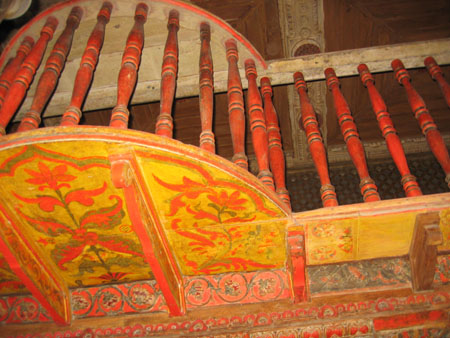
Some of a synagogue removed from South India in the Isræl Museum.
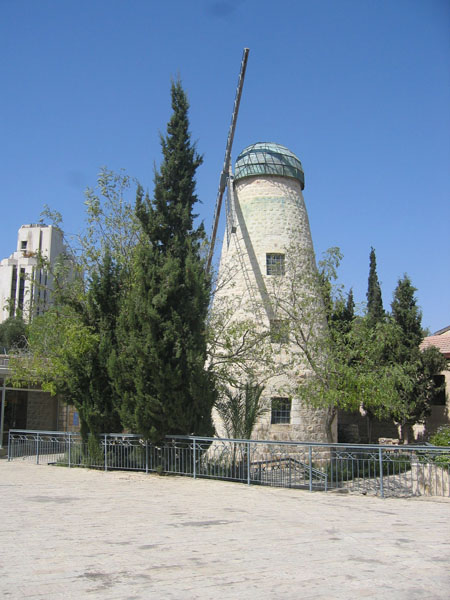
The famous Dutch windmill in West Jerusalem.
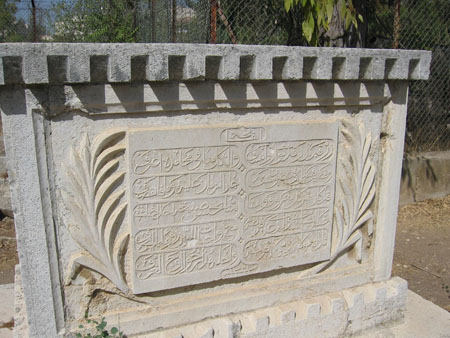
An Arab grave in West Jerusalem's Independence Park.
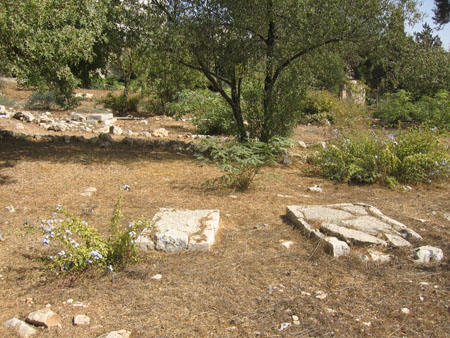
Ruins of Arab graves in Independence Park.
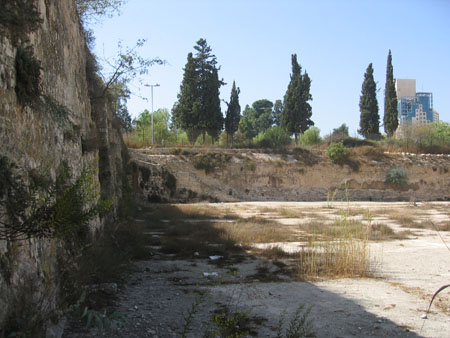
The reservoir in Jerusalem's Independence Park. Note the cyprus trees, typical of the Mediterranean.
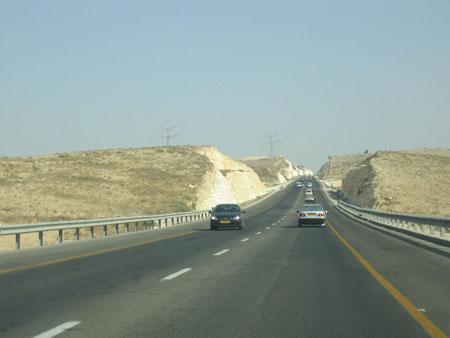
The road cuts through a chalk hill near Beer Sheva.
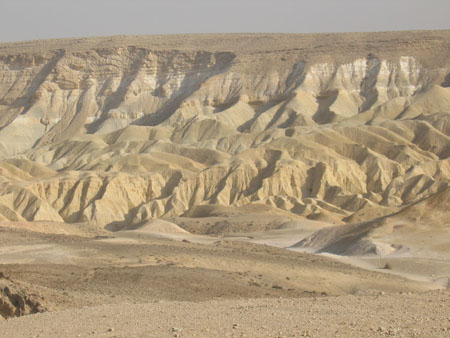
The first spectacular wadi, heading south from Beer Sheva.
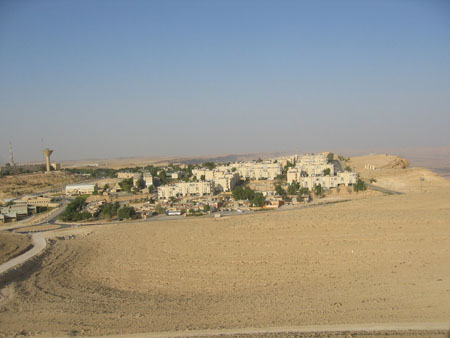
All of Mitzpe Ramon, viewed from the Camel Lookout.
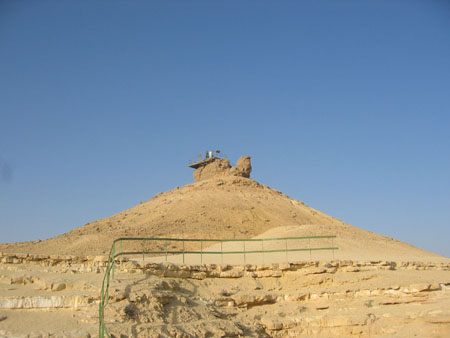
Camel Lookout at Mitzpe Ramon. Note that it is perched atop a remnant of lava that flowed over the limestone desert. Also note how the green safety fence in the foreground unceremoniously ends while the cliff continues.
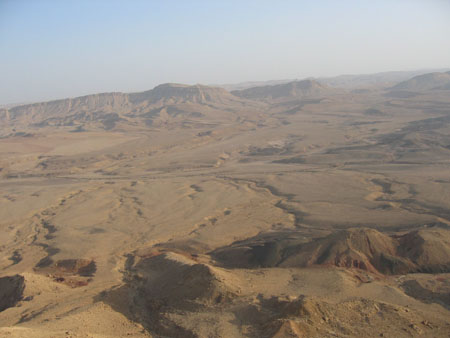
"The Crater" viewed from Mitzpe Ramon.
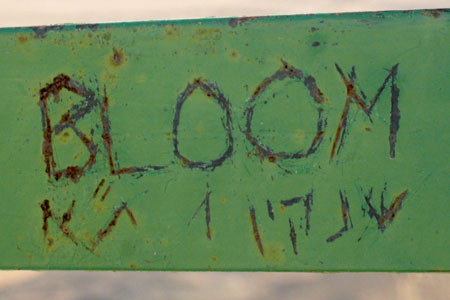
Graffiti on the metal fence at the precipice of Mitzpe Ramon. Other names included "Cohen" and "Goldberg."
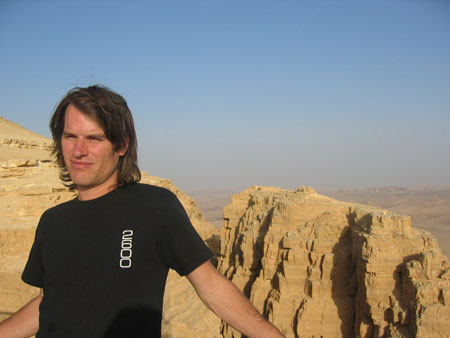
Me at Mitzpe Ramon.
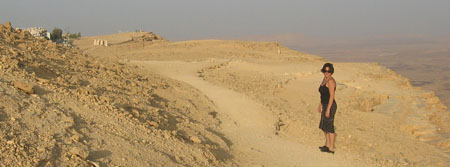
Gretchen with Mitzpe Ramon peeking out behind her.
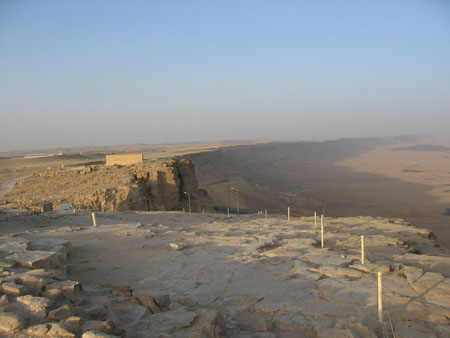
View from the Mitzpe Ramon Visitor's Center.
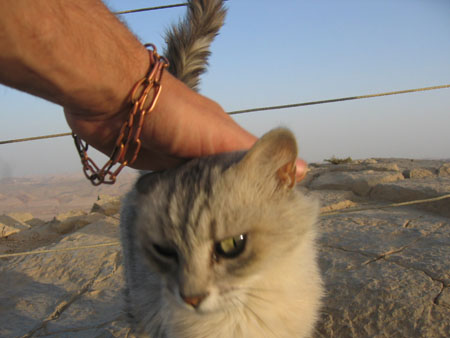
As elsewhere in Isræl, cats were common in Mitzpe Ramon. I saw at least two with this unusual desert-themed coloring; this one lived in the rocky jumble just beyond the precipice at the Visitor's Center.
For linking purposes this article's URL is:
http://asecular.com/blog.php?051003 feedback
previous | next |














